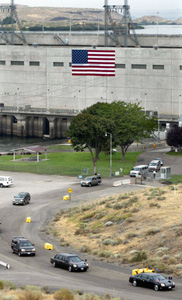forum
library
tutorial
contact

Bush Promotes Salmon Restoration in Northwest
by Jim HauserTalon News, August 25, 2003
|
the film forum library tutorial contact |

|
Bush Promotes Salmon Restoration in Northwestby Jim HauserTalon News, August 25, 2003 |
 BURBANK, WA -- President Bush ended a two-day swing through the Pacific Northwest last week with a visit to the Ice Harbor Lock and Dam. While there he reiterated his administration's commitment to increase funding and research to enhance salmon production in the area.v
"I appreciate the commitment that we are making as a country, and that you're making as a community, for salmon restoration," said President Bush. "What I saw was, and what you know, firsthand, is that we can have good, clean hydroelectric power and salmon restoration going on at the same time."
BURBANK, WA -- President Bush ended a two-day swing through the Pacific Northwest last week with a visit to the Ice Harbor Lock and Dam. While there he reiterated his administration's commitment to increase funding and research to enhance salmon production in the area.v
"I appreciate the commitment that we are making as a country, and that you're making as a community, for salmon restoration," said President Bush. "What I saw was, and what you know, firsthand, is that we can have good, clean hydroelectric power and salmon restoration going on at the same time."
Hydroelectric dams have long been blamed by environmental groups for the decline in salmon populations. One such group calling themselves the Wild Angels and based in Santa Fe, New Mexico says that Pacific Northwest Salmon are "rapidly approaching extinction, largely due to dams, which block migration paths of fish swimming up and downstream. Four dams on Lower Snake River, between Lewiston, Idaho and the Columbia River, are particularly devastating to Snake River salmon." They, along with other environmental groups, have advocated the removal or breaching of the four dams on the Lower Snake River as the only means available to increase salmon numbers. However, such a move would impact the electrical power generating capacity of the Pacific Northwest which relies heavily on hydroelectric power.
Washington State alone derives 80% of its power for hydroelectricity and other states outside the region, especially California, which depends on out-of-state power generators for almost half of its electricity, would be seriously affected by any such action.
Direct Service Industries, Inc, a non-profit association comprised of companies who purchase electric power directly from the Bonneville Power Administration published a statement in 1996 that addressed this issue.
"Northwest citizens concerned with the environment need to remember that hydroelectric power is the only available large scale renewable electric resource," they said. "Even with a societal commitment to conservation, nearly every kilowatt of electric capacity removed from the Columbia River is ultimately made up through increased electric production from other sources, principally fossil fuels."
The report says that the Federal government has never prepared an environmental impact statement to assess the environmental costs of removing hydroelectric capacity, even though over one thousand megawatts of energy, enough to serve the city of Seattle, has already been removed through operational changes with apparently little or no benefit to salmon.
"The economy of this part of the world has relied upon the steady supply of hydropower," said President Bush. "And we've got an energy problem in America. We don't need to be breaching any dams that are producing electricity. And we won't."
Past administrations as well as the current Bush administration are focusing on methods that will foster increased salmon numbers without impacting electrical power needs and river navigation. Hatchery programs, specially designed screens, salmon ladders, bypasses and programs to capture and transport salmon hatchlings around the dams have all contributed to rising numbers in the salmon populations.
Salmon runs in the Columbia River Basin, which includes the Ice Harbor Lock and Dam, increased from 628,452 fish to nearly 1.7 million from 1992 to 2002, according to Bob Lohn, the regional administrator for the National Marine Fisheries Service.
"We have shown the world that we can have a good quality of life and, at the same time, save salmon," President Bush said. "And that's exactly what this administration will continue to do."
The Bush administration has requested $707 million in FY 2004 for coastal and river salmon recovery efforts. This is an increase of $165 million more than the amount enacted in FY 2001. The funding is allocated to Federal agencies that annually contribute towards salmon recovery as well as to the Pacific Salmon Recovery Fund which is used to assist states, tribes, and local governments that carry out additional salmon projects.
learn more on topics covered in the film
see the video
read the script
learn the songs
discussion forum
